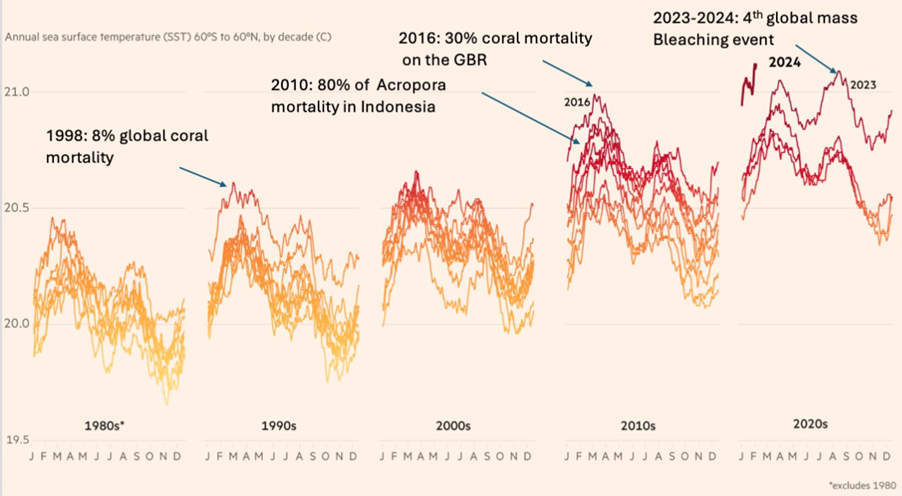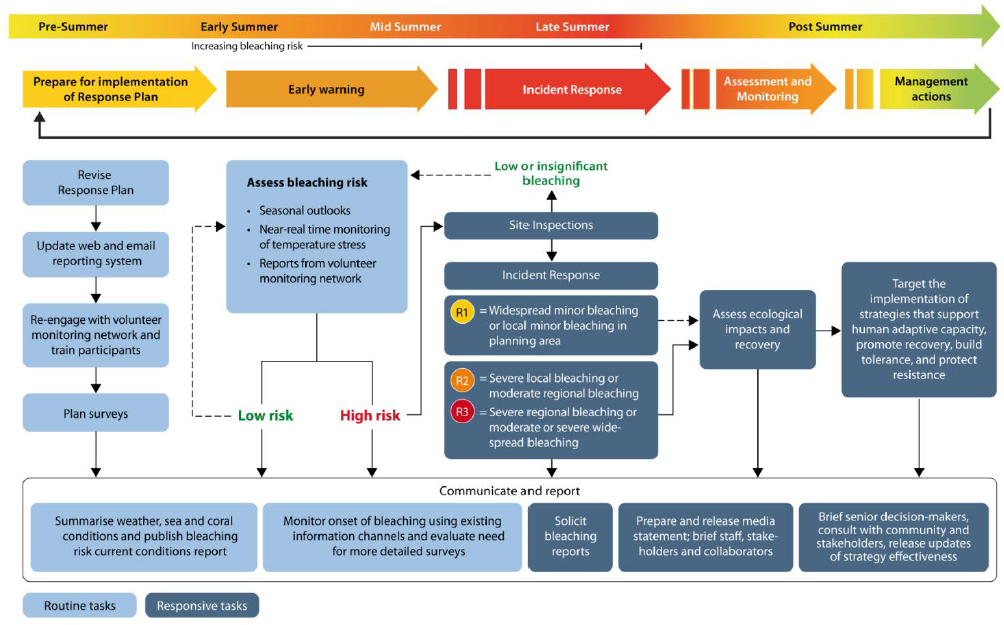Mass Bleaching
Coral bleaching is a major stress response of corals, causing them to expel their symbiont algae, turn white, and sometimes die. By 2050, 90% of coral reefs are expected to experience coral bleaching annually.
Mass bleaching events refer to observations of bleached corals spanning hundreds or even thousands of kilometers, thereby affecting entire ecosystems. The frequency and severity of mass bleaching events have been increasing over the last few decades, causing reef degradation at a global scale.
Over the last 30 years, three global-scale coral bleaching events have occurred in 1997-1998, 2009-2010, and 2014-2017 (as reported by Hughes et al. in 2018). The 4th global mass bleaching event was declared by NOAA and ICRI in 2024 with bleaching recorded in at least 53 countries since February 2023, in concert with the ongoing El Niño. Strong El Niño events have historically been linked to severe bleaching events, but recently, large-scale and severe events have occurred during La Niña periods. This suggests that ocean temperatures have increased to the point whereby large-scale bleaching events may now occur during any phase of ENSO.

Estimated global and regional coral loss during four mass coral bleaching events in the last three decades. Credit: Financial Time. Source: Climate Realinizer, NOAA OISST 2.1., Souter et al. 2020, Hughes et al. 2018, ICRI 2010
Ecological and Socio-Economic Impacts
Mass coral bleaching has devastating impacts on corals and coral reef communities. Corals that are bleached or recovering from bleaching are likely to experience reduced growth rates, decreased reproductive capacity, increased susceptibility to diseases and elevated mortality rates. In addition, widespread coral mortality following a bleaching event can alter coral community composition, due to the selective loss of the more susceptible species, as well as reef-scale declines in genetic and species diversity. Reef degradation from coral bleaching erodes the quality and quantity of reef ecosystem services such as coastal protection, fisheries production, and recreation. These can have catastrophic consequences on the livelihoods of communities and increase their vulnerability to poverty and malnutrition.
Management Strategies
While local management cannot directly control the causes of coral bleaching, reef managers play important roles before, during, and after bleaching events. Their responsibilities typically include predicting and communicating risks, assessing impacts, understanding implications for reef resilience, and implementing management actions to reduce the severity of damage and support reef recovery.
A bleaching response plan describes the steps for detecting, assessing, and responding to bleaching events. It enables managers to be ready should a bleaching event occur. Bleaching response plans can take many forms, from a complete management response framework (e.g., Great Barrier Reef Marine Park Authority’s Incidence Response System) including an incident control system and field procedures to a simple one-page description of key steps and triggers.
The four main elements of a bleaching response plan are:
- An early warning system
- Impact assessment
- Management interventions
- Communications
The Reef Resilience Network developed a worksheet to guide managers through developing a bleaching response plan.

Coral bleaching response plan developed by the Great Barrier Reef Marine Park Authority (GBMPA) in Australia. Source: GBRMPA 2011
A range of coral bleaching monitoring tools is available to managers worldwide, including remote sensing platforms like the Allen Coral Atlas, global monitoring programs such as Reef Check and MERMAID, and regional networks like the Coral Reef Alliance. Sharing observations across these regional and global networks is essential to enhance understanding, improve mitigation strategies, and strengthen adaptation efforts in response to coral bleaching events.
Once a reef has been affected by a coral bleaching event, managers might wish to consider local management interventions or restoration strategies to support recovery processes. However, coral bleaching events often occur at spatial scales of tens to hundreds of kilometers, making restoration an expensive and difficult—if not impossible—prospect.
